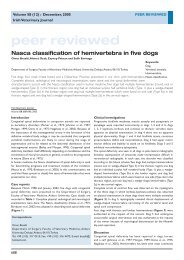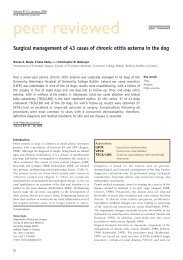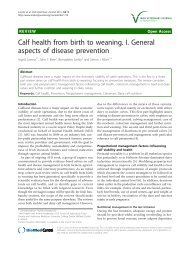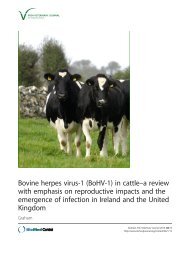Correlation of the Havemeyer endoscopic laryngeal grading system ...
Correlation of the Havemeyer endoscopic laryngeal grading system ...
Correlation of the Havemeyer endoscopic laryngeal grading system ...
You also want an ePaper? Increase the reach of your titles
YUMPU automatically turns print PDFs into web optimized ePapers that Google loves.
PEER reviewed<br />
<strong>Correlation</strong> <strong>of</strong> <strong>the</strong> <strong>Havemeyer</strong><br />
<strong>endoscopic</strong> <strong>laryngeal</strong><br />
<strong>grading</strong> <strong>system</strong> with<br />
histopathological changes<br />
in equine cricoarytenoideus<br />
dorsalis muscles<br />
Collins N 1,2 , Milne E 1 , Hahn C 1 and Dixon P 1<br />
1<br />
The Royal (Dick) School <strong>of</strong> Veterinary Sciences, University <strong>of</strong> Edinburgh, Easter Bush Veterinary Centre,<br />
Roslin, Midlothian, EH25 9RG, Scotland<br />
2<br />
Scone Veterinary Hospital, Clovelly Intensive Care Unit, 10 St Aubins Street, Scone,<br />
New South Wales 2337, Australia<br />
Abstract<br />
The establishment <strong>of</strong> a single validated <strong>endoscopic</strong> <strong>laryngeal</strong> <strong>grading</strong> <strong>system</strong> for assessing recurrent <strong>laryngeal</strong> neuropathy (RLN) is<br />
desirable to facilitate direct comparisons between <strong>the</strong> findings <strong>of</strong> different clinical and research groups worldwide. The objective <strong>of</strong><br />
this study was to assess <strong>the</strong> relationship between <strong>the</strong> <strong>Havemeyer</strong> <strong>endoscopic</strong> <strong>laryngeal</strong> <strong>grading</strong> <strong>system</strong> and histopathological changes<br />
consistent with RLN in <strong>the</strong> left cricoarytenoideus dorsalis (CAD) muscle <strong>of</strong> horses <strong>of</strong> different breeds with a full range <strong>of</strong> clinical severities<br />
<strong>of</strong> RLN, i.e., from normal <strong>endoscopic</strong> <strong>laryngeal</strong> function to complete <strong>laryngeal</strong> hemiplegia. Endoscopic <strong>grading</strong> <strong>of</strong> <strong>laryngeal</strong> function <strong>of</strong><br />
22 horses was performed using <strong>the</strong> <strong>Havemeyer</strong> <strong>endoscopic</strong> <strong>laryngeal</strong> <strong>grading</strong> <strong>system</strong>. A biopsy sample <strong>of</strong> <strong>the</strong> left CAD muscle was<br />
obtained from each horse, ei<strong>the</strong>r at post mortem examination (n=16), or during routine laryngoplasty surgery (n=6). A semi-quantitative<br />
histopathological scoring <strong>system</strong> was used to grade <strong>the</strong> severity <strong>of</strong> histopathological lesions consistent with RLN in <strong>the</strong> left CAD muscle <strong>of</strong><br />
each horse. A significant positive correlation (r s<br />
=0.705, p
normal horses to have histopathological <strong>laryngeal</strong> muscle<br />
changes indicative <strong>of</strong> denervation atrophy.<br />
Resting <strong>laryngeal</strong> endoscopy is currently <strong>the</strong> most commonly<br />
used method for diagnosing and assessing RLN in equine<br />
practice (Dixon 2003; Ducharme 2003; Lane et al. 2006)<br />
and is largely based on <strong>the</strong> degree <strong>of</strong> abduction obtained<br />
and maintained by <strong>the</strong> suspect arytenoid cartilages.<br />
Research on RLN has been hampered by <strong>the</strong> lack <strong>of</strong><br />
agreement on <strong>the</strong> <strong>endoscopic</strong> <strong>grading</strong> <strong>of</strong> <strong>laryngeal</strong> function,<br />
which has made direct comparisons between <strong>the</strong> findings<br />
<strong>of</strong> different clinical and research groups difficult. The three<br />
most commonly used <strong>laryngeal</strong> <strong>endoscopic</strong> <strong>grading</strong> <strong>system</strong>s<br />
are <strong>the</strong> 4-grade scheme (Ducharme et al. 1991; Hackett<br />
et al. 1991), <strong>the</strong> 5-grade scheme (Lane et al. 2006) and<br />
<strong>the</strong> 6-grade scheme (Dixon et al. 2001). Of <strong>the</strong> above three<br />
<strong>system</strong>s, <strong>the</strong> 4-grade <strong>system</strong> (Ducharme et al. 1991) is<br />
currently <strong>the</strong> most widely used.<br />
The introduction <strong>of</strong> <strong>the</strong> <strong>Havemeyer</strong> <strong>endoscopic</strong> <strong>laryngeal</strong><br />
<strong>grading</strong> <strong>system</strong> in 2003 represented a consensus agreement<br />
from prominent equine clinicians and researchers worldwide<br />
(Dixon et al. 2003). The <strong>grading</strong> <strong>system</strong> was based on an<br />
amalgamation <strong>of</strong> <strong>the</strong> above-noted, three <strong>grading</strong> <strong>system</strong>s.<br />
However, <strong>the</strong> <strong>Havemeyer</strong> <strong>endoscopic</strong> <strong>laryngeal</strong> <strong>grading</strong><br />
<strong>system</strong> has not as yet been objectively validated, nor has it<br />
achieved universal acceptance. The purpose <strong>of</strong> this study was<br />
to examine <strong>the</strong> correlation between <strong>the</strong> various <strong>Havemeyer</strong><br />
grades and sub-grades <strong>of</strong> <strong>laryngeal</strong> function, and <strong>the</strong> degree <strong>of</strong><br />
histopathological changes consistent with RLN present in <strong>the</strong><br />
left cricoarytenoideus dorsalis (CAD) muscle <strong>of</strong> horses with <strong>the</strong><br />
full range <strong>of</strong> clinical severities, i.e., from normal <strong>endoscopic</strong><br />
<strong>laryngeal</strong> function to complete <strong>laryngeal</strong> hemiplegia.<br />
Materials and methods<br />
The study was performed using appropriate Home Office<br />
project and personal licences. Signed owner consent was<br />
obtained prior to inclusion <strong>of</strong> each horse in <strong>the</strong> study.<br />
Because <strong>of</strong> <strong>the</strong> noted, widespread prevalence <strong>of</strong> sub-clinical<br />
RLN, and also <strong>of</strong> unrecognised clinical RLN in <strong>the</strong> general<br />
equine population, samples were obtained from 16 randomly<br />
selected horses that were euthanised electively as a result<br />
<strong>of</strong> various clinical disorders not related to <strong>the</strong> respiratory<br />
tract. No evaluation <strong>of</strong> upper respiratory tract function at<br />
exercise was performed in <strong>the</strong>se 16 horses. Samples were<br />
also collected during routine laryngoplasty surgery (n=6)<br />
from horses with severe clinical RLN.<br />
The 22 horses had a median age <strong>of</strong> seven years (range 1-29<br />
years) and comprised 11 Thoroughbreds, six Thoroughbred<br />
crosses, three Warmbloods, one Friesian and one pony<br />
(Table 1). Twenty-four hours prior to sample collection, resting<br />
<strong>laryngeal</strong> video-endoscopy (Olympus CF Type 200 HL) was<br />
performed (without sedation and with head collar restraint<br />
only) to assess <strong>the</strong> symmetry, synchrony and range <strong>of</strong><br />
arytenoid movements during quiet breathing, following at<br />
least three swallows and during temporary occlusion <strong>of</strong> <strong>the</strong><br />
external nares. The video-recorded <strong>laryngeal</strong> movements for<br />
all horses were reviewed and independently graded using <strong>the</strong><br />
<strong>Havemeyer</strong> <strong>endoscopic</strong> <strong>laryngeal</strong> <strong>grading</strong> <strong>system</strong> (Table 2) by<br />
two assessors, Padraic Dixon and Niamh Collins.<br />
Table 1: Summary <strong>of</strong> age, breed, biopsy source, <strong>Havemeyer</strong> grades and sub-grades<br />
<strong>of</strong> left <strong>laryngeal</strong> function, and myopathy histological score <strong>of</strong> <strong>the</strong> left CAD muscles<br />
from <strong>the</strong> 22 horses in <strong>the</strong> study<br />
TB=Thoroughbred; TBx=Thoroughbred cross; FR=Friesian; WB=Warmblood;<br />
P.M.=post-mortem examination; CAD=cricoarytenoideus dorsalis.<br />
Horse<br />
number<br />
Age<br />
(years)<br />
Breed<br />
Biopsy<br />
obtained<br />
<strong>Havemeyer</strong><br />
grade and<br />
sub-grade<br />
<strong>of</strong> left<br />
<strong>laryngeal</strong><br />
function<br />
Myopathy<br />
histological<br />
score<br />
left CAD<br />
muscle<br />
Horse 1 11 TBx P.M. I 10.5<br />
Horse 2 29 Pony P.M. I 10.5<br />
Horse 3 1 TB P.M. I 8<br />
Horse 4 6 TB P.M. II.1 10<br />
Horse 5 7 TB P.M. II.1 8.5<br />
Horse 6 7 FR P.M. II.1 16<br />
Horse 7 13 TBx P.M. II.1 16.5<br />
Horse 8 15 TB P.M. II.2 8<br />
Horse 9 15 TBx P.M. II.2 10.5<br />
Horse 10 2 WB P.M. II.2 9<br />
Horse 11 7 WB P.M. III.1 11.5<br />
Horse 12 17 TBx P.M. III.1 14<br />
Horse 13 6 TB P.M. III.1 10.5<br />
Horse 14 2 TB P.M. III.1 8.5<br />
Horse 15 6 TB Surgery III.1 18<br />
Horse 16 14 TB P.M. III.2 24.5<br />
Horse 17 10 WB P.M. III.2 23.5<br />
Horse 18 9 TBx Surgery III.2 14.5<br />
Horse 19 7 TB Surgery III.3 23.5<br />
Horse 20 8 TB Surgery III.3 21.5<br />
Horse 21 5 TB Surgery IV 24<br />
Horse 22 4 TBx Surgery IV 22.5<br />
Sharply dissected samples (circa 1 cm x 1 cm in cross<br />
section) <strong>of</strong> <strong>the</strong> lateral belly <strong>of</strong> <strong>the</strong> left CAD muscle were<br />
obtained ei<strong>the</strong>r within an hour <strong>of</strong> euthanasia or at surgery<br />
(circa 0.5 cm x 0.5 cm in cross section). Samples were<br />
immediately frozen in isopentane cooled in liquid nitrogen<br />
and <strong>the</strong>n stored at -80 o C in plastic universal containers<br />
until processing. Serial sections (12 µm thick) <strong>of</strong> all muscle<br />
samples were made in transverse planes using a cryostat<br />
microtome maintained at -20 o C. Sections were stained<br />
with haematoxylin and eosin, oil red O, modified Gomori’s<br />
trichrome and myosin adenosine triphosphatase at pH 9.4<br />
(Dubowitz 1985).<br />
Muscle sections from each horse were coded and<br />
independently assessed blinded by two assessors,<br />
Niamh Collins and Elspeth Milne, using light microscopy,<br />
for evidence <strong>of</strong> secondary histopathological changes<br />
consistent with RLN. The semi-quantitative histopathological<br />
<strong>grading</strong> <strong>system</strong> used was adapted from that <strong>of</strong> Duncan<br />
et al. (1991). The following histopathological parameters<br />
were subjectively scored from one (absent), two (focal<br />
distribution), three (multifocal distribution) to four (diffusely<br />
affected): single fibre atrophy, small group atrophy, large<br />
PEER reviewed<br />
Irish Veterinary Journal Volume 62 Number 5 335
PEER reviewed<br />
Table 2: Summary <strong>of</strong> <strong>the</strong> <strong>Havemeyer</strong> <strong>endoscopic</strong> <strong>laryngeal</strong> <strong>grading</strong> <strong>system</strong> (Dixon<br />
et al. 2003)<br />
Grade Description Sub-grade<br />
I<br />
II<br />
III<br />
IV<br />
All arytenoid cartilage<br />
movements are synchronous<br />
and symmetrical.<br />
Full arytenoid cartilage<br />
abduction can be achieved and<br />
maintained.<br />
Arytenoid cartilage movements<br />
are asynchronous and/or<br />
larynx is asymmetrical at times,<br />
but full arytenoid cartilage<br />
abduction can be achieved and<br />
maintained.<br />
Arytenoid cartilage movements<br />
are asynchronous and/or<br />
asymmetric. Full arytenoid<br />
cartilage abduction cannot be<br />
achieved and maintained.<br />
Complete immobility <strong>of</strong> <strong>the</strong><br />
arytenoid cartilage and vocal<br />
fold.<br />
1: Transient asynchrony, flutter<br />
or delayed movements seen.<br />
2: There is asymmetry <strong>of</strong> <strong>the</strong><br />
rima glottidis much <strong>of</strong> <strong>the</strong> time<br />
due to reduced mobility <strong>of</strong> <strong>the</strong><br />
affected arytenoid and vocal<br />
fold, but <strong>the</strong>re are occasions,<br />
typically after swallowing or<br />
nasal occlusion, when full<br />
symmetrical abduction is<br />
achieved and maintained.<br />
1: There is asymmetry <strong>of</strong> <strong>the</strong><br />
rima glottidis much <strong>of</strong> <strong>the</strong> time<br />
due to reduced mobility <strong>of</strong> <strong>the</strong><br />
arytenoid and vocal fold, but<br />
<strong>the</strong>re are occasions, typically<br />
after swallowing or nasal<br />
occlusion, when full symmetrical<br />
abduction is achieved, but not<br />
maintained.<br />
2: Obvious arytenoid abductor<br />
deficit and arytenoid asymmetry.<br />
Full abduction is never achieved.<br />
3: Marked, but not total<br />
arytenoid abductor deficit and<br />
asymmetry with little arytenoid<br />
movement. Full abduction is<br />
never achieved.<br />
group atrophy, hypertrophy, nuclear clumps, fibre type<br />
grouping and fat and/or fibrous replacement <strong>of</strong> muscle<br />
fibres. The myopathy histological score was calculated for<br />
each assessor for each left CAD muscle by summing <strong>the</strong><br />
individual scores for each <strong>of</strong> <strong>the</strong>se seven histopathological<br />
parameters.<br />
For <strong>the</strong> correlation <strong>of</strong> <strong>endoscopic</strong> and histopathological<br />
changes, <strong>the</strong> pairs <strong>of</strong> observations from <strong>the</strong> two<br />
independent assessors for <strong>Havemeyer</strong> grade and sub-grade<br />
<strong>of</strong> <strong>laryngeal</strong> function, and <strong>the</strong> pairs <strong>of</strong> observations from<br />
<strong>the</strong> two independent assessors for myopathy histological<br />
score, were ranked and tested with a Wilcoxon’s signed<br />
rank test. The correlation between <strong>the</strong> ranked <strong>Havemeyer</strong><br />
grades and sub-grades <strong>of</strong> <strong>laryngeal</strong> function, and <strong>the</strong><br />
ranked myopathy histological score <strong>of</strong> <strong>the</strong> 22 horses was<br />
tested using a Spearman’s rank correlation test. For all<br />
tests, a probability <strong>of</strong>
Left CAD myopathy historological score<br />
25<br />
20<br />
15<br />
10<br />
5<br />
I II.1 II.2 III.1 III.2 III.3 IV<br />
<strong>Havemeyer</strong> <strong>endoscopic</strong> grade <strong>of</strong> left <strong>laryngeal</strong> function<br />
Figure 1: Modified scatterplot comparing <strong>the</strong> left CAD myopathy histological score<br />
and <strong>the</strong> <strong>Havemeyer</strong> <strong>endoscopic</strong> grade <strong>of</strong> left <strong>laryngeal</strong> function <strong>of</strong> <strong>the</strong> horses in<br />
<strong>the</strong> study. The values <strong>of</strong> two horses (Horse 1 and Horse 2) with grade I <strong>laryngeal</strong><br />
function and left CAD myopathy histological scores <strong>of</strong> 10.5 have been graphically<br />
altered to make both visible.<br />
CAD=cricoarytenoideus dorsalis muscle<br />
<strong>of</strong> fur<strong>the</strong>r diagnostic procedures such as high-speed<br />
treadmill endoscopy. It would also facilitate more accurate<br />
comparison between RLN findings from different clinical<br />
and research groups.<br />
Ducharme (2003) described <strong>the</strong> three main objectives <strong>of</strong><br />
an <strong>endoscopic</strong> <strong>laryngeal</strong> <strong>grading</strong> <strong>system</strong>:<br />
1) it must be a simple practical <strong>system</strong>;<br />
2) it must be consistent between observers; and,<br />
3) it must correlate with <strong>laryngeal</strong> function during exercise.<br />
The <strong>Havemeyer</strong> <strong>endoscopic</strong> <strong>laryngeal</strong> <strong>grading</strong> <strong>system</strong><br />
appeared to be simple, practical and clinically applicable,<br />
as <strong>the</strong> major grades and sub-grades could be readily<br />
applied to all 22 horses in <strong>the</strong> present study. The<br />
<strong>endoscopic</strong> results were consistent between <strong>the</strong> assessors,<br />
with no statistically significant difference found between<br />
<strong>the</strong> grades and sub-grades independently allocated to<br />
<strong>laryngeal</strong> function by both assessors.<br />
In <strong>the</strong> 16 horses where muscle samples were obtained at<br />
post mortem examination (Table 1), nei<strong>the</strong>r <strong>the</strong> performance<br />
history nor <strong>the</strong> possible existence <strong>of</strong> abnormal respiratory<br />
noises at exercise were investigated, and <strong>the</strong> <strong>grading</strong> <strong>of</strong><br />
<strong>laryngeal</strong> function was based solely on <strong>the</strong> result <strong>of</strong> a<br />
single resting <strong>endoscopic</strong> examination. Performing resting<br />
<strong>endoscopic</strong> examinations in isolation has limitations,<br />
which have been described previously (Lane et al. 2006).<br />
Interestingly, in <strong>the</strong>se 16 horses, which were mainly<br />
euthanised for intractable musculoskeletal problems, a<br />
wide range <strong>of</strong> <strong>laryngeal</strong> function was evident (grade I-III.2),<br />
including six (38%) horses with grade III <strong>laryngeal</strong> function,<br />
confirming <strong>the</strong> widespread presence <strong>of</strong> sub-clinical, and<br />
unrecognised RLN in <strong>the</strong> general equine population. Only<br />
one previous study (Ducharme 2005) has attempted to<br />
correlate resting <strong>Havemeyer</strong> grades with performance<br />
at exercise. In that study <strong>of</strong> 461 horses, all 201 horses<br />
with grade I <strong>laryngeal</strong> function and 96% <strong>of</strong> 117 horses<br />
with grade II <strong>laryngeal</strong> function had normal arytenoid<br />
abduction during high-speed treadmill endoscopy. Eighty<br />
per cent <strong>of</strong> 126 horses with grade III <strong>laryngeal</strong> function<br />
had some degree <strong>of</strong> arytenoid and/or vocal cord collapse<br />
at exercise, and all 17 horses with grade IV <strong>laryngeal</strong><br />
function had <strong>laryngeal</strong> collapse at exercise. Ducharme’s<br />
study unfortunately did not individually evaluate <strong>the</strong> various<br />
<strong>Havemeyer</strong> sub-grades. Fur<strong>the</strong>r studies correlating <strong>the</strong><br />
resting <strong>Havemeyer</strong> grades and sub-grades with <strong>laryngeal</strong><br />
function at exercise are required to assess <strong>the</strong> accuracy<br />
with which <strong>the</strong> resting <strong>Havemeyer</strong> grades and sub-grades<br />
can be used as a predictor <strong>of</strong> <strong>laryngeal</strong> function during<br />
strenuous exercise.<br />
The <strong>Havemeyer</strong> <strong>endoscopic</strong> <strong>laryngeal</strong> <strong>grading</strong> <strong>system</strong> was<br />
found to broadly correlate with <strong>the</strong> left CAD myopathy<br />
histological score (r s<br />
=0.705; p
PEER reviewed<br />
<strong>Havemeyer</strong> grades and sub-grades with <strong>laryngeal</strong> function<br />
at exercise could fur<strong>the</strong>r support <strong>the</strong> adoption <strong>of</strong> <strong>the</strong><br />
<strong>Havemeyer</strong> <strong>endoscopic</strong> <strong>laryngeal</strong> <strong>grading</strong> <strong>system</strong> as <strong>the</strong><br />
standard <strong>endoscopic</strong> <strong>laryngeal</strong> <strong>grading</strong> <strong>system</strong> in horses.<br />
Acknowledgements<br />
This study was supported by funding from <strong>the</strong> Horserace<br />
Betting Levy Board. We thank Dr Darren J Shaw for<br />
assistance with <strong>the</strong> statistical analysis and data<br />
presentation and Neil MacIntyre for invaluable laboratory<br />
assistance.<br />
References<br />
Anderson LJ (1984) A study <strong>of</strong> some muscles <strong>of</strong> <strong>the</strong> equine<br />
larynx and s<strong>of</strong>t palate. PhD <strong>the</strong>sis. Massey University,<br />
New Zealand.<br />
Brakenh<strong>of</strong>f JE, Holcombe SJ, Hauptman JG et al. (2006)<br />
The prevalence <strong>of</strong> <strong>laryngeal</strong> disease in a large<br />
population <strong>of</strong> competition draft horses. Veterinary<br />
Surgery 35, 579-583.<br />
Cahill JI, Goulden BE (1986a) Equine <strong>laryngeal</strong> hemiplegia.<br />
Part I. A light microscopic study <strong>of</strong> peripheral nerves.<br />
New Zealand Veterinary Journal 34, 161-169.<br />
Cahill JI, Goulden BE (1986b) Equine <strong>laryngeal</strong> hemiplegia.<br />
Part 11. An electron microscopic study <strong>of</strong> peripheral<br />
nerves. New Zealand Veterinary Journal 34, 170-175.<br />
Cahill JI, Goulden BE (1986c) Equine <strong>laryngeal</strong> hemiplegia.<br />
Part IV. Muscle pathology. New Zealand Veterinary<br />
Journal 34, 186-190.<br />
Cole CR (1946) Changes in <strong>the</strong> equine larynx associated<br />
with <strong>laryngeal</strong> hemiplegia. American Journal <strong>of</strong><br />
Veterinary Research 7, 69-77.<br />
Derksen FJ, Stick JA, Scott EA et al. (1986) Effects <strong>of</strong><br />
<strong>laryngeal</strong> hemiplegia and laryngoplasty on airflow<br />
mechanics in exercising horses. American Journal <strong>of</strong><br />
Veterinary Research 47, 16-20.<br />
Dixon PM, McGorum BC, Railton DI et al. (2001) Laryngeal<br />
paralysis: a study <strong>of</strong> 375 cases in a mixed-breed<br />
population <strong>of</strong> horses. Equine Veterinary Journal 33,<br />
452-458.<br />
Dixon PM (2003) Endoscopic <strong>grading</strong> <strong>system</strong>s for <strong>laryngeal</strong><br />
paralysis-6 grade <strong>system</strong>. In: Proceedings <strong>of</strong> a<br />
workshop on equine recurrent <strong>laryngeal</strong> neuropathy,<br />
<strong>Havemeyer</strong> Foundation Monograph Series No. 11.<br />
Pp 26-27. Dixon PM, Robinson NE and Wad JF (eds).<br />
Newmarket, R&W Publications.<br />
Dixon PM, Robinson NE and Wade J (2003) Workshop<br />
summary. In: Proceedings <strong>of</strong> a workshop on equine<br />
recurrent <strong>laryngeal</strong> neuropathy, <strong>Havemeyer</strong> Foundation<br />
Monograph Series No. 11. Pp 93-97. Dixon PM,<br />
Robinson NE and Wad JF (eds). Newmarket, R&W<br />
Publications.<br />
Dubowitz V (1985) Histological and histochemical stains<br />
and reactions. In: Muscle biopsies – a practical<br />
approach. (2nd edn). Pp 19-40. Dubowitz V and Brooke<br />
MH (eds). London, Bailliere Tindall.<br />
Ducharme NG, Hackett RP, Fubini SL et al. (1991) The<br />
reliability <strong>of</strong> <strong>endoscopic</strong> examination in assessment<br />
<strong>of</strong> arytenoid cartilage movement in horses. Part 11.<br />
Influence <strong>of</strong> side <strong>of</strong> examination, re-examination, and<br />
sedation. Veterinary Surgery 20, 180-184.<br />
Ducharme N (2003) 4-grade <strong>system</strong> for equine <strong>laryngeal</strong><br />
function. In: Proceedings <strong>of</strong> a Workshop on Equine<br />
Recurrent Laryngeal Neuropathy, <strong>Havemeyer</strong><br />
Foundation Monograph Series No. 11. Pp 21-23. PM<br />
Dixon, NE Robinson and JF Wade (eds.) Newmarket,<br />
R&W Publications.<br />
Ducharme NG (2005) Upper airway: clinical perspectives.<br />
In: Proceedings <strong>of</strong> <strong>the</strong> world equine airway symposium.<br />
Pp 85-94. New York, Itaca.<br />
Duncan ID, Griffiths IR, McQueen A et al. (1974) The<br />
pathology <strong>of</strong> equine <strong>laryngeal</strong> hemiplegia. Acta<br />
Neuropathologica 27, 337-348.<br />
Duncan ID, Baker GJ, Heffron, CJ et al. (1977) A correlation<br />
<strong>of</strong> <strong>the</strong> <strong>endoscopic</strong> and pathological changes in<br />
subclinical pathology <strong>of</strong> <strong>the</strong> horse’s larynx. Equine<br />
Veterinary Journal 9, 220-225.<br />
Duncan ID, Griffiths IR and Madrid RE (1978) A light and<br />
electron microscopic study <strong>of</strong> <strong>the</strong> neuropathy <strong>of</strong> equine<br />
idiopathic <strong>laryngeal</strong> hemiplegia. Neuropathological<br />
Applied Neurobiology 4, 483-501.<br />
Duncan ID, Hammang JP (1987) Ultrastructural<br />
observations <strong>of</strong> organelle accumulation in <strong>the</strong> equine<br />
recurrent <strong>laryngeal</strong> nerve. Journal <strong>of</strong> Neurocytology 16,<br />
269-280.<br />
Duncan ID, Amundson J, Cuddon PA et al. (1991).<br />
Preferential denervation <strong>of</strong> <strong>the</strong> adductor muscles <strong>of</strong> <strong>the</strong><br />
equine larynx. 1: muscle pathology. Equine Veterinary<br />
Journal 23, 94-98.<br />
Fleming G (1889) Roaring in Horses (laryngismus<br />
paralyticus). Pp 1-159. London, Balliere, Tindall and<br />
Cox.<br />
Griffiths IR (1991) The pathogenesis <strong>of</strong> equine <strong>laryngeal</strong><br />
hemiplegia. Equine Veterinary Journal 23, 75-76.<br />
Gunn HM (1972) Histochemical observations on <strong>laryngeal</strong><br />
skeletal muscle fibres in ‘normal’ horses. Equine<br />
Veterinary Journal 4, 144-148<br />
Gunn HM (1973) Fur<strong>the</strong>r observations on <strong>laryngeal</strong> skeletal<br />
muscle in <strong>the</strong> horse. Equine Veterinary Journal 5,<br />
77-80.<br />
Hackett RP, Ducharme NG, Fubini SL et al. (1991) The<br />
reliability <strong>of</strong> <strong>endoscopic</strong> examination in assessment<br />
<strong>of</strong> arytenoid cartilage movement in horses. Part<br />
1: Subjective and objective <strong>laryngeal</strong> evaluation.<br />
Veterinary Surgery 20, 174-179.<br />
Lane JG, Bladon B, Little DR et al. (2006) Dynamic<br />
obstructions <strong>of</strong> <strong>the</strong> equine upper respiratory tract.<br />
Part 2: Comparison <strong>of</strong> <strong>endoscopic</strong> findings at rest<br />
and during high-speed treadmill exercise <strong>of</strong> 600<br />
Thoroughbred racehorses. Equine Veterinary Journal<br />
38, 401-408.<br />
Stick JA, Peloso JG, Morehead JP J et al. (2001)<br />
Endoscopic assessment <strong>of</strong> airway function as a<br />
predictor <strong>of</strong> racing performance in Thoroughbred<br />
yearlings: 427 cases (1997-2000). Journal <strong>of</strong> American<br />
Veterinary Medical Association 219, 962-96.<br />
338<br />
Irish Veterinary Journal Volume 62 Number 5







